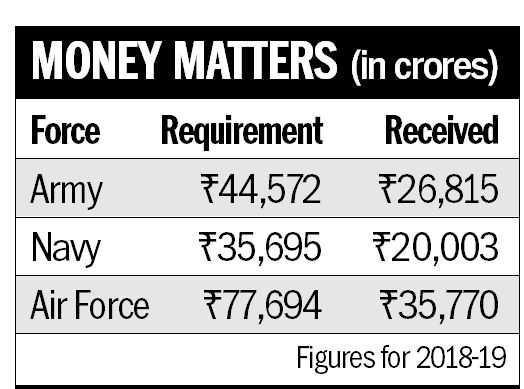
Ajay Banerjee in New Delhi
India’s military equipment modernisation is on the path of ‘gradual change’— a mixed-bag with success in a few cases and delay in some. Some of the key projects have picked up the pace and new technologies have entered the modern battlefield. However, the execution is still fettered by fiscal constraints.
From here on — over the next five to seven years — the profile, weaponry, equipment and the ability of the armed forces will undergo a change, or rather, will need to undergo a change to effectively tackle a two-front war scenario, besides cross-border terrorism in Jammu and Kashmir.
Faced with modern-day warfare, India has military satellites, but it needs more. New Delhi has the edge in supersonic missiles due to the BrahMos. However, its nuclear missiles — Agni and Prithvi series — have less than 50 per cent range of what is possessed by China. Besides, Beijing also possesses long-range air defence systems such as S-300 and S-400.
India has vastly improved its radars and surveillance over the sea and also in airspace across the western and northern frontiers. New Delhi still does not possess armed UAVs. Its submarine fleet is one-fourth that of China’s fleet of 62 vessels while the pace of warship building is much-slower than Beijing’s. Air defence systems such as the Akash missiles are undergoing another upgrade and the next version of tanks is still on the drawing board.
Changes that look good
By September 2019, the first Rafale jets will be delivered to India. The delivery of Boeing AH-64E Apache Longbow attack helicopters and the Chinook heavy-lift choppers will also start this year. Air Vice Marshal Manmohan Bahadur (retd), additional director general, Centre for Air Power Studies, says, “Rafale, Chinook and Apache are not mere aircraft or copters. These should be seen as ‘systems’ as they bring top-end search and fight capabilities. The weapon delivery system will be revolutionary.”
In the past few months, the first artillery guns in 30 years were inducted since Bofors. The induction started for 145 ultra-light howitzers (M777) procured from the US and also for 100 K9 VAJRA-T artillery guns.
In October last year, India inked a multi-billion contract with Russia for S-400 missiles. Another deal for advanced surface-to-air missile systems from Israel has been agreed upon for warships.
The aircraft carrier, INS Vikrant, delayed by six years, is finally set to sail in 2020.
Since 2015, the Defence Ministry informed Parliament on December 31 last, it had signed 188 contracts for capital procurement of defence equipment. Lt Gen Subrata Saha (retd), a former Deputy Chief of the Army, says: “A lot is being done. The question is ‘can more be done’? And the answer is, ‘yes’.”
The ones in the pipeline
The government inked a pact with an Indian firm this year for supplying 1.86 lakh bulletproof jackets to the Army and also a new version of helmets — a requirement that should have been fulfilled years ago. Tenders are out for 6.5 lakh assault rifles and 60,000 light machine guns. However, the Modi government’s flagship programme ‘Strategic Partnership’ that aims to have foreign companies participating in the Indian private sector has not kicked off.
The Navy is finally on its way to making up its shortfall of submarines with the induction of the Kalvari class of submarines, which have been built in India.
The IAF needs more fighter jets. In March last year, India started the procurement of 110 jets by issuing a request for information for the deal. There are apprehensions that “nothing will move till the 2019 polls”.
The gradual climb
The latest figures, tabled in the Lok Sabha on January 2, reveal that despite best efforts, the actual expenditure incurred under capital acquisition (modernisation) for the past five years has been, at best, a ‘gradual climb’ from Rs 66,850 crore in 2013-14 to Rs 72,732 crore in 2017-2018 (see chart).
The defence expenditure is budgeted at Rs 3,80,690 crore for the fiscal ending March 31, 2019. This is 17.16 per cent of the Centre’s expenditure. The salary component works out to be Rs 1,18,966 crore and is 40 per cent of the budget. In March, 2018, a parliamentary panel said the defence budget for 2018-19 was “inadequate” and “barely enough” to cater to inflation.




























